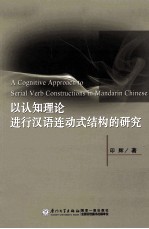
- 作 者:印辉著
- 出 版 社:厦门:厦门大学出版社
- 出版年份:2012
- ISBN:9787561545270
- 标注页数:179 页
- PDF页数:191 页
请阅读订购服务说明与试读!
订购服务说明
1、本站所有的书默认都是PDF格式,该格式图书只能阅读和打印,不能再次编辑。
2、除分上下册或者多册的情况下,一般PDF页数一定要大于标注页数才建议下单购买。【本资源191 ≥179页】
图书下载及付费说明
1、所有的电子图书为PDF格式,支持电脑、手机、平板等各类电子设备阅读;可以任意拷贝文件到不同的阅读设备里进行阅读。
2、电子图书在提交订单后一般半小时内处理完成,最晚48小时内处理完成。(非工作日购买会延迟)
3、所有的电子图书都是原书直接扫描方式制作而成。
Chapter 1 Introduction 1
Chapter 2 Past Treatments of Serial Verb Constructions 4
2.1 Past Approaches to SVCs 4
2.1.1 Christaller(1875) 4
2.1.2 Westermann(1930) 6
2.1.3 Stewart(1963) 7
2.1.4 Bamgbose(1974) 9
2.1.5 Baker(1989) 11
2.1.6 Agbedor(1994) 13
2.1.7 Aikhenvald(2006) 17
2.2 Past Approaches to Chinese SVCs 21
2.2.1 Chao(1968) 21
2.2.2 Li and Thompson(1981) 23
2.2.3 Dai(1990) 24
2.2.4 Paul(2004) 27
2.3 Discussion 31
Chapter 3 Basic Tenets of Cognitive Grammar 32
3.1 Assumptions of Cognitive Grammar 32
3.2 Symbolization 34
3.3 Construction and Composition 36
3.4 Base vs.Profile 38
3.5 Construal 39
3.6 Perspective 40
3 7 Action Chain 42
3.8 Lexicon and Syntax 42
3.9 Schematic Representation of a Transitive Event 44
Chapter 4 The Present Analysis 45
4.1 Three Iconically Based Semantic Principles 45
4.1.1 Principle of Temporal Sequence and Scope 46
4.1.2 Principle of Shared Participants 48
4.1.3 Principle of Situational Dependence 48
4.2 Conceptual Event 49
4.3 Laying Out the Event Conflation Continuum 53
4.4 Event Structure of Coordination,Subordination,and SVCs 54
4.5 Morphosyntactic and Prosodic Tests of Event Conflation 57
Chapter 5 The Five Constructions and the Seven Tests 62
5.1 Coordinate Constructions 62
5.1.1 Schematic Representation 62
5.1.2 Application of Tests 63
5.1.3 Discussion 64
5.2 Complement Constructions 65
5.2.1 Schematic Representation 65
5.2.2 Application of Tests 68
5.2.3 Discussion 70
5.3 Purposive Constructions 70
5.3.1 Purposive Complements or Separate Clauses 70
5.3.2 The Three Principles Reflected in Purposive SVCs 72
5.3.3 Schematic Representation 75
5.3.4 Application of the Tests 75
5.3.5 Discussion 77
5.4 Double-headed or Shared Object Constructions 78
5.4.1 The Three Principles Reflected in Double-headed Constructions 79
5.4.2 Schematic Representation 80
5.4.3 Application of Tests 82
5.4.4 Discussion 83
5.5 The So-called VV Compounds—A Continuum Between Lexicon and syntax 84
5.5.1 Parallel VV Compounds 84
5.5.2 Phase VV Compounds 85
5.5.3 Resultative VV Compounds 87
5.5.4 Directional VV Compounds 89
5.6 VV Compounds as SVCs 93
5.6.1 SVCs with Complements of Result 94
5.6.2 SVCs with Complements of Direction 99
5.6.3 Schematic Representation 104
5.6.4 Application of Tests 104
5.7 Discussion 106
Chapter 6 Coverb Constructions 111
6.1 Traditional Criteria 112
6.2 Problematic Criteria 112
6.3 Verbhood Tests 115
6 4 Present Analysis 116
6.4.1 Coverbs—A Continuum 116
6.4.2 Entities Undergoing Process 118
6.5 Metaphorical and Functional Extensions 118
6.5.1 Na'take'—Instrumental and Topic Marker 119
6.5.2 Ba—Object Marker 120
6.5.3 Gei(give)—Recipient Marker and Benefactive Use 120
6.6 Differences between SVCs and CoVCs 121
Chapter 7 Psycholinguistic Experiments 124
7.1 Experiment One 124
7.2 Experiment Two 126
Chapter 8 The Association of Multi-Verb Constructions with Verbs 128
8.1 Coordinate Construction 129
8.2 Complement Construction 132
8.3 Purposive Construction 139
8.4 Shared Object Construction 145
8.5 Compound Construction 147
8.5.1 Contiguous Compounds Containing Lai'Come'and Qu'Go' 150
8.5.2 Contiguous Compounds Containing Motion Verbs other than Lai and Qu 157
Chapter 9 Conclusions 161
Bibliography 164
